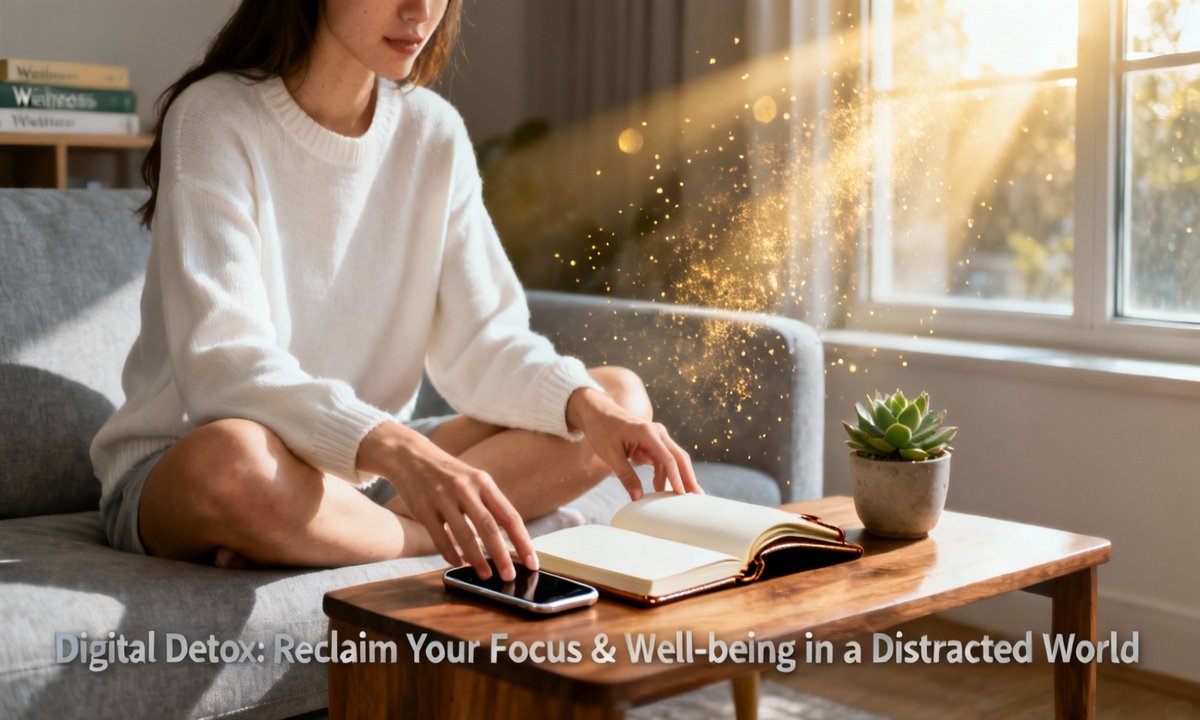It’s easy to lose track of time scrolling through a phone, often without realizing how much of the day has slipped away. Many people spend a significant portion of their waking hours looking at screens, surrounded by constant notifications and digital stimulation. This often leaves individuals feeling overwhelmed, unfocused, and sometimes even disconnected from themselves.
This guide aims to show how a digital detox can bring back mental clarity and support overall well-being. It offers simple strategies, known benefits, and practical steps to help reduce digital overload, even if a complete break isn’t possible right now.
Understanding Digital Overload: Its Symptoms and Roots
Digital overload is more than just feeling busy; it’s a mental and physical exhaustion caused by too much information and constant screen-based activity. Common indicators often include a restless mind, difficulty focusing, and disrupted sleep patterns. Physical signs like eye strain or headaches, alongside increased stress, are also frequently reported.
Many people experience these signs without connecting them to their daily digital routines. Finding focus in our highly distracted world has become a common and increasingly vital quest for many.
Why Our Attention is Constantly Captured
Modern algorithms are specifically crafted to hold our attention for extended periods. Each notification or scroll can trigger a small release of dopamine, which is the brain’s reward chemical. This process can train our nervous system to seek constant stimulation, making breaks from devices feel unsettling.
When both our digital and physical environments become cluttered, it can be challenging to discern what truly matters. This sense of disarray isn’t just internal; it often extends to our devices, social media feeds, and email inboxes. To support a fresh start, considering both digital and physical decluttering can be beneficial. You might explore storage solutions to simplify your living space while addressing your tech habits.
Are You Experiencing Digital Overload?
You might wonder if a digital detox is something you could benefit from. Key indicators to observe include struggling to focus on one task or feeling compelled to check your emails and social feeds constantly. Experiencing restlessness or anxiety when separated from devices, along with mental fog, can also be telling signs.
Physical symptoms, such as frequent headaches, eye strain, and trouble sleeping, are also widespread for those facing digital overload. Many individuals report that these uncomfortable symptoms tend to lessen significantly, often within just a few days of consciously reducing their screen time.
The Significant Advantages of Disconnecting
Embracing a digital detox is more than a passing trend; it’s a scientifically supported approach for enhancing mental health and productivity. Research indicates that reducing screen time and spending more moments offline can significantly improve various aspects of life.
These improvements often include a boost in concentration and memory, alongside a noticeable reduction in stress and anxiety levels. Many also experience better sleep quality and find that their real-life relationships become stronger. For instance, studies have shown that even a week away from social media can lead to a significant decrease in stress and an increase in overall well-being. Research suggests these positive effects are amplified when combined with thoughtful technology habits.
Digital Detox Compared to Digital Minimalism
While a digital detox involves a temporary break from devices, digital minimalism focuses on using technology with clear intention. It means only keeping what genuinely contributes to your well-being and simplifies your life. If you’re looking to make smarter choices about home technology, exploring essential gadgets that simplify life can offer useful tips for organizing your digital surroundings.
Your Practical Guide to a Successful Digital Detox
1. Preparing Your Space for Disconnection
Begin by informing friends and colleagues that you will be less accessible for a period. Consider putting your devices on airplane mode or setting a specific “do not disturb” time, perhaps after 8 PM each evening. It can also be helpful to remove distracting applications or mute non-essential alerts from your phone.
Furthermore, make your physical environment welcoming for activities that don’t involve screens. This could mean arranging books, setting out craft supplies, or simply creating a comfortable spot for relaxation. These small preparations can significantly support your detox efforts.
2. Defining Your Goals and Setting Boundaries
Clearly decide on the type of detox you wish to undertake. This could range from a full detox, where all screens are avoided for 24 to 72 hours, to a focused fast, allowing work but cutting out social media. Alternatively, you might opt for scheduled device-free periods, such as during mealtimes.
It is also beneficial to clearly articulate your reasons for undertaking this detox. Whether your aim is to achieve deeper focus, enjoy better rest, or cultivate more meaningful connections, having a clear purpose can help maintain your motivation throughout the process.
3. Embracing Offline Activities
Dedicate your newly freed time to pursuits you genuinely enjoy and that do not involve screens. Activities like taking a walk in nature, delving into a good book, journaling, or trying out a new recipe can be incredibly rewarding. Practicing meditation or yoga are also excellent alternatives.
Even minor adjustments can make a substantial difference in your well-being. Spending just 30 minutes each day offline has the potential to enhance your mental health and restore a feeling of control over your time and attention.
Cultivating Mindful Technology Use for Lasting Well-being
After a successful digital detox, the goal is to integrate intentional digital habits into your daily life. This includes using only applications that are truly necessary or bring you genuine joy, and establishing clear device-free zones within your home, such as bedrooms or dining areas.
Implementing tech curfews and grouping digital tasks together can also help prevent mindless checking of devices. To embrace truly mindful technology use, regularly ask yourself how an app serves you and whether it makes you feel more connected or simply drained.
Maintaining an organized digital space further supports your commitment to these habits. For ongoing efforts in simplification and home wellness, consider exploring minimalist home gadgets and practical decluttering tips.
The Impact of Regular Digital Decluttering
Regular “mini” detoxes can be highly effective, such as dedicating one evening a week to being completely tech-free or designating Sundays as phone-off days. Over time, these consistent habits can gradually rewire your brain, enhancing your capacity for focus and calm. This process helps to lessen the powerful hold of compulsive scrolling and digital distractions in your daily life.
Strategies for Overcoming Common Digital Distractions
Digital distractions seem to be present everywhere in our modern lives. They might appear as work emails intruding on vacation time, social media vying for attention during meals, or flashy app alerts interrupting almost any moment.
Practical Tips to Manage Screen Time
To effectively manage your screen time, consider turning off push notifications for applications that aren’t essential. Another helpful strategy is to move any distracting apps off your phone’s main home screen, making them less immediately accessible. Using grayscale mode on your device can also lessen visual temptation.
Additionally, exploring applications designed to block distracting websites during your focus periods can be incredibly beneficial. It’s important to remember that these strategies are not about feeling deprived; rather, they are about actively creating more space and time for what truly holds meaning in your life.
Addressing Challenges When Disconnecting Feels Difficult
If you experience intense digital Fear Of Missing Out (FOMO) or feel strong withdrawal symptoms, it’s wise to begin with smaller steps. Try shortening your periods of disconnection and don’t hesitate to seek support from others. Remember that this journey is a gradual process.
Evidence suggests that making short, consistently repeatable adjustments, instead of imposing drastic restrictions, is far more likely to result in lasting positive change.
Real-World Transformations: Stories of Digital Detox Success
Individuals from diverse backgrounds have shared accounts of significant benefits gained from implementing a digital detox. For example, many professionals have found renewed focus, a decrease in burnout, and enhanced creativity after establishing daily “device curfews.”
Parents have reported strengthening their family bonds by dedicating evenings to completely offline activities, fostering deeper connections. Students, too, have seen improvements in their study results by grouping screen time and taking regular tech-free walks, highlighting the broad impact of disconnecting.
Common Questions About Digital Detox
How Frequently Should One Consider a Digital Detox?
Many specialists suggest a full 24-hour detox once a month, complemented by shorter, daily breaks from devices. However, the most effective approach is to listen to your personal needs and circumstances. Sometimes, even a weekend-long break or consistent device-free evenings can yield significant positive changes for your well-being.
Is a Digital Detox Possible for Those Who Work Online?
Yes, absolutely. For individuals who work online, a focused detox is a practical approach. This involves retaining only the essential tools for your work while removing social media, news, and entertainment applications. Utilizing time-tracking apps can help you identify digital usage patterns and establish healthier limits for your daily routines.
Could Detoxing Impact Personal Relationships Negatively?
It is a good idea to communicate your detox plans to loved ones in advance and suggest engaging in offline activities together. Many people discover that intentionally disconnecting from devices actually strengthens real-life friendships and helps reduce the presence of online drama.
Harmonizing Digital Detox with Your Home Environment
Your immediate surroundings play a crucial role in supporting or hindering your digital well-being. Incorporating elements like houseplants, maximizing natural light, and setting up inviting analog spaces can greatly contribute to a calmer atmosphere. For further practical lifestyle advice, you might review related guides on minimalist home gadgets.
Exploring decluttering tips can also help create a peaceful, distraction-free living environment. Considering eco-friendly décor or gentle organizing methods can further enhance this sense of calm and promote overall home wellness.
Conclusion: Embracing Mindful Connection and Freedom
Taking a break from screens is not just an act of willpower; it’s about actively fostering a supportive environment for your mind and overall life. Digital detoxes serve as an essential tool for regaining focus, alleviating stress, and reconnecting with what truly brings meaning to your existence.
Are you prepared to embark on your own detox journey? Consider setting aside an hour offline today and observe the positive changes in your feelings. Feel free to explore other practical guides for cultivating a simpler, happier home environment. Remember, navigating our digital world mindfully is a shared learning experience.



